Margery Doig, Date & Location Unknown
(Source: Sala)
 |
Margery Doig was born August 14, 1900. Soon, she was the sole member of her immediate family, as her father died in 1914 and her mother and brother passed away in the early 1920's. In 1955 she suffered a cerebral aneurysm and was paralyzed. According to her family, cited in the right sidebar, she had a hard time coping with her lot. She filed her Final Flight Plan on September 8, 1973. She was among the 42 notable female signers of the Davis-Monthan Register.
The date and location of the photograph, right are unknown. The portrait is signed by Doig to an unidentified recipient, "With all my love, Dear. Marge."
She landed at Tucson and is signed in the Register on August 3, 1930. She arrived with Marion Grevemberg flying Pitcairn NC96W. There are excellent images of 96W, some provided by her family, at her airplane's link. Doig and Grevemberg were westbound from El Paso, TX to Los Angeles, CA. Grevemberg was then chief pilot with the Curtiss-Wright Company, and had been Doig's primary flight instructor in Bridgeport, CT. Her airplane was barely two months old. She bought it on May 29, 1930 at the factory under the name of "Doig Realty Company". See the link for the airplane, and the information below from her pilot flight log book, for details around the purchase.
Contemporary Photo of Travel Air NC9917 (Source: Pitcairn)
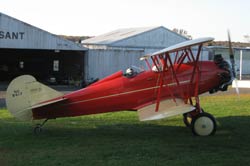 |
There are two conjectures surrounding her Register entry. These arose from examining her 1929-1934 flight log (2.7MB) provided to us by her family. First is the actual date of her visit. The Register on page 142 clearly records her arrival on August 3rd. The handwriting in the Register is not hers (probably Grevemberg's), but her personal flight log records her visit on August 1st (On page 22. Please note, when I refer to a page in her flight log book, I mean the page number in the PDF document). In her log it looks like she made a series of entries at the same time, perhaps resolving a few days' flights at the same time. It would not be unusual for her to overlook the exact date. Or it may have been Grevemberg who got the date wrong when he signed the Register.
While we're talking about her flight log, there is at least one other airplane in her log, the Travel Air 4000 N9917, which, although not a Register airplane, is still flying. A recent photograph is above. You can also see an image of it at the link. Image and link courtesy of David Pitcairn.
Further, Mr. Pitcairn points out page 17 of Doig's flight log. There, she has identified "NC213W" as one of the aircraft she flew when visiting the Pitcairn factory. He says about this log entry, "The Pitcairn PA-7 mailwing NC213W in the logbook does not exist according to company records. However the PA-7 prototype was NC213M (s/n 50) and is pictured on page 280, volume 2 in Juptner. It was probably retained as a factory demonstrator so it is likely she flew 213M and somehow flipped the W."
Margery Doig, Ca. 1916
(Source: Sala)
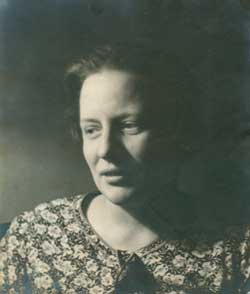 |
But, I digress. The second discrepancy has to do with who was actually flying her airplane. She arrived with Grevemberg, whose signature appears in the Register in the pilot's column, with Doig listed as passenger. According to her pilot log, however, she was the pilot and Grevemberg was the passenger. You can see her log entry on page 18 of her log PDF. Take a look; you can make your own decision.
Margery Doig's page is especially rich in photographs, anecdotes and news articles that are shared with us by her family. In some cases, the information and photos are dated and sourced, in some cases not. This is typical for information that has been clipped and collected over the years and stored in boxes.
Curiously, we know about as much about her aviation exploits as we do about her as a person. Daughter Susan states, "I don't know if my mother owned a realty company but I do know her family owned a lot of real estate in New York and Connecticut ....around 1932 she went to work for a department store on Fifth Avenue and flew for recreation on weekends. My mother never talked much about this part of her life.... Her only cousin that she kept in touch with died in 2001 so I don't have anyone to ask about her flying days."
For your convenience I divide this page into segments, LEARNING TO FLY (just below), FORMATION OF THE NINTY-NINES, AIR RACING, TOTAL FLIGHT EXPERIENCE, AIRPORT AERIAL VIEWS, and MISCELLANEOUS. Please click on the links to be taken directly to each section, or just scroll down and enjoy the story as it unfolds.
LEARNING TO FLY
According to her flight log, she first soloed in a Curtiss Fledgling, registration number 8672 (not a Register airplane), on August 16, 1929. She acquired a State of Connecticut license (#190) based on her check flight with "Captain Generous". Her state license is below, left, dated September 26, 1929, signed by Harry W. Generous. Compare this with her flight log, page 7.
Margery Doig, State of Connecticut Pilot License
(Source: Sala)
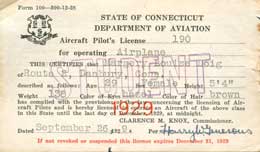 |
Margery Doig, Federal Pilot License, November 16, 1929
(Source: Sala)
 |
Margery Doig, State of Connecticut Pilot License, Sheath
(Source: Sala)
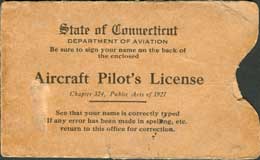 |
Margery Doig, Federal Pilot License, November 16, 1929, Back
(Source: Sala)
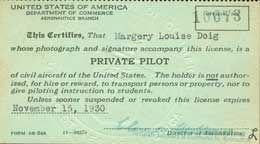 |
Bridgeport Newspaper Article, April 28, 1930 (Source: Sala)
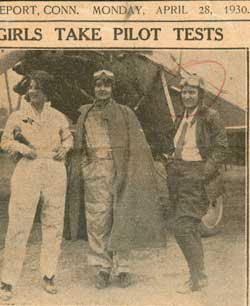 |
A copy of her Federal private pilot license, number 10078, is above, right. Her signature tells us she was not the one who signed the Register, rather it was probably Marion Grevemberg. This copy of her license was in force, and on her person, when she visited Tucson.
This news article, left, from her local Bridgeport, CT newspaper noted her receipt of her pilot certification. Doig is circled in red. The other two women are Margaret Huber and Novetah Holmes. The article does not say which one is which.
The day before, the article below appeared that built more prose around Doig's accomplishments. Her fellow student Margaret Huber is also mentioned.
Bridgeport Newspaper Article, April 27, 1930 (Source: Sala)
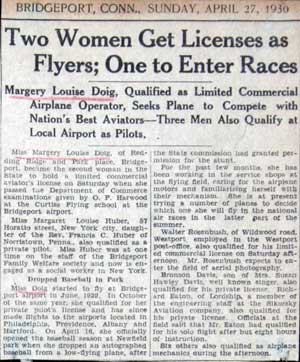 |
Her flight log is instructive, as it allows us to piece together various activities, such as her cross-country flights, the purchase of NC96W and her participation in the 1930 National Air Races (NAR). For example, on March 4, 1930, she and instructor Grevemberg flew the schools' Fledgling from Bridgeport, CT to Providence, RI. She logged it (on page 13) as dual instruction.
Note the article at the bottom of the first column mentions her throwing down a baseball from her airplane at the opening of the baseball season. You can see a photograph of her below in her flight experience section doing just that. Further note that she is , "... at present trying a number of planes to decide which one she will fly in the national air races in the latter part of the summer."
News Article, Undated & Unsourced, Quota Club Meeting
(Source: Sala)
 |
On May 3, 1930 (page 17 of her log PDF) we find her flying from Bridgeport to Pitcairn field in Pennsylvania. There she flies two Pitcairn PA-7 aircraft, NC213W and NC96W. She bought 96W. Early in her flying career, Doig was a booster of women's aviation. Soon after acquiring her license, she participated in a panel presentation at the Quota Club, founded in 1919 as the first international women's service organization. The article, left, describes how and what the participants presented. This article is undated and unsourced, but it probably is late 1929-early 1930.
In this article, Doig (circled in red at the left of the photo) is cited as being the first woman to acquire a pilot's license in the state of Connecticut. She states, "... flying is the most normal thing in the world."
Another participant, Frances Harall (later Frances Marsalis), next to Doig in the front row, goes further and states, "Flying is just the hottest thing." Marsalis would die in an airplane crash in August, 1934.
BACK TO TOP
---o0o---
FORMATION OF THE NINETY-NINES
Flight to Curtiss Field, LI, NY, Ca. November, 1929
(Source: Sala)
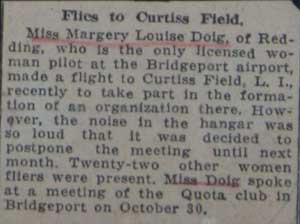 |
Margery Doig was a charter member of the women pilot's association known as the Ninety-Nines. It was formed on November 2, 1929. The news article below records the first meeting of the group (22 by count of names, although the article states there were 24) at Valley Stream, LI, NY. The article claims that Doig arrived for the meeting by airplane, but there is nothing in her flight log (page 11) to suggest she flew there herself.
Furthermore, the 99s Web site (link above) states that the weather was foul on that day and that most attendees drove to the meeting. But, the news article, right, documents the fact she flew there solo regardless of the weather. We'll never know for sure. This article also cites her speaking at the Quoto Club documented above.
See Bobbi Trout, another charter member, for some anecdotes about the formation of the 99s.
Formation of the 99s, November 4, 1929
(Source: Sala)
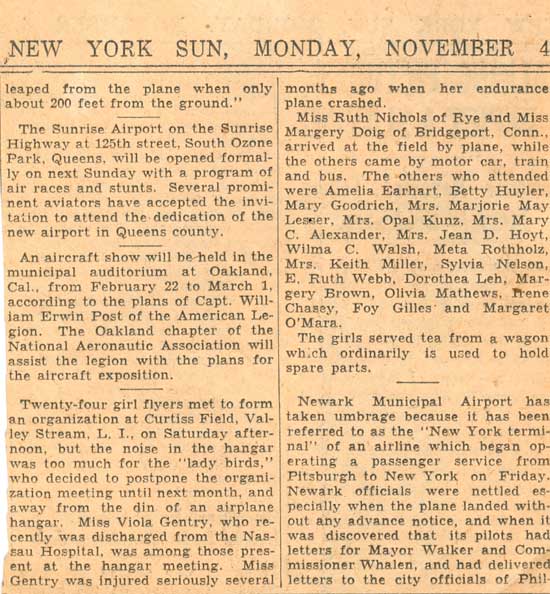 |
Below, Doig's membership card for the 99s during 1933-34. The interesting logo in the upper left corner was designed by the husband of fellow member Opal Kunz.
Margery Doig's Ninety-Nines Membership Card, 1933-34
(Source: Sala)
 |
The formation of the 99s was interesting, in that the club was originally informally named basically for the number of women who initially responded and demonstrated their interest in the club. Below, two news articles that demonstrate the evolution of the organization's name. It was at one time called the 86s, 90s, 91s and the 97s. Both these articles are unsourced and undated. They are probably circa 1929 or early 1930.
The 97s Meet at Newark, Doig Circled in Red
(Source: Sala)
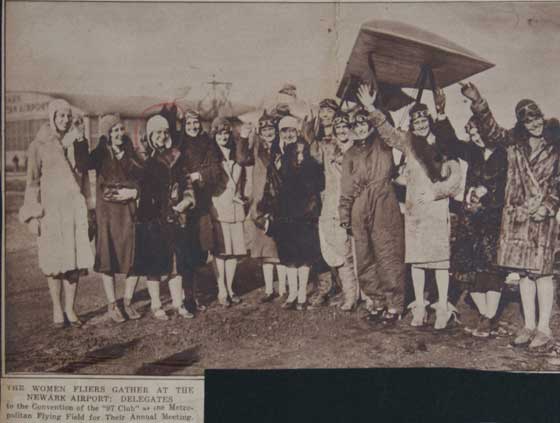 |
Informatively, the larger article below lists all the names of 89 charter members. Among them, Ruth Elder Camp, Doig, Amelia Earhart, Lady Mary Heath, Opal Kunz, Jean LaRene, Ruth Nichols, Gladys O'Donnell, Phoebe Omlie, Neva Paris, Joan Shankle (misspelled "Shenkle"), Ruth Stewart, Bobbie Trout and Mary Von Mach. All these women signed the Davis-Monthan Airfield Register and are commemorated on their individual biographical pages on dmairfield.org.
Evolution of the 99s, Undated & Unsourced News Article, Ca. 1929
(Source: Sala)
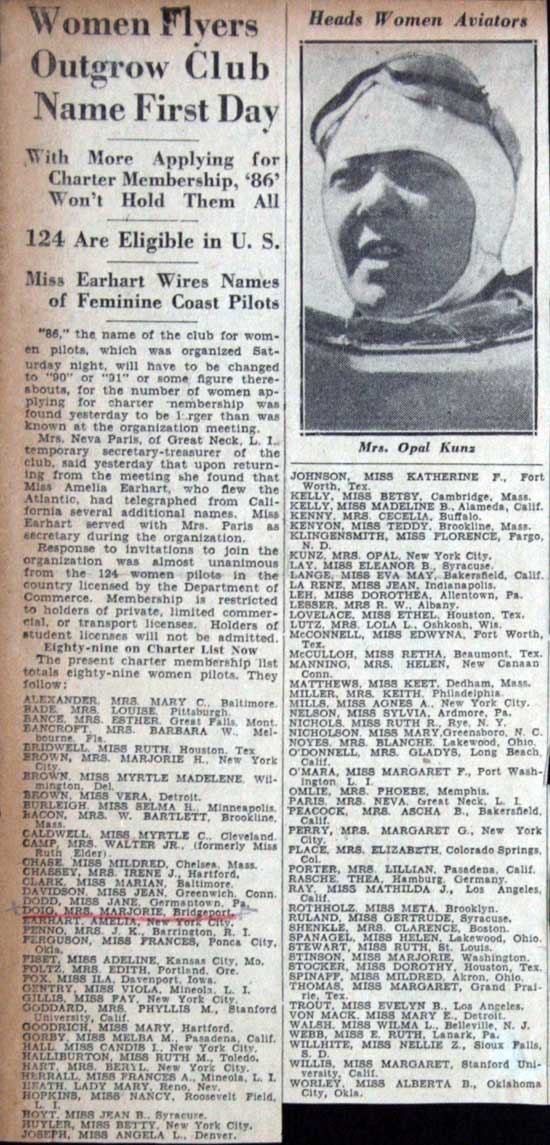 |
BACK TO TOP
---o0o---
AIR RACING
Allentown, PA Air Meet, June 21-27, 1930
(Source: Sala)
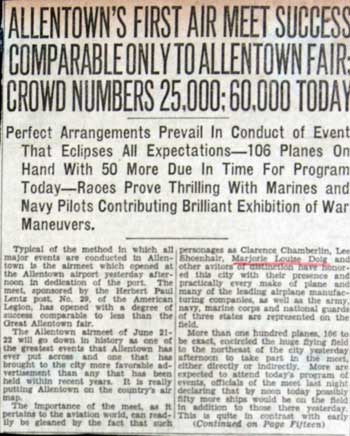 |
She flew 96W for about 20 hours before heading from Connecticut to Allentown, PA on June 21, 1930 for what she described in her log as a "Women's Race". This meet is cited in the truncated, undated and unsourced news article at left. This was a big deal air show for the time, with 106 aircraft participating. She took first place in the Women's Race.
Flush with victory, on July 20th she embarked on her cross-country trip to the NAR. You can find the beginning of this trip documented on page 19 of her flight log. Grevemberg was her passenger.
Doig had flown for a little over a year before she enrolled in competition for the 1930 NAR. The 1930 race ran from Long Beach, CA to Curtiss-Reynolds Airport in Chicago, IL. The records provided by her family document very well her participation in the event. Her pilot log, pages 23-26, records her itinerary for the race, as well as her position at the end of each leg.
Part of her preparation included acquiring a special license to enable her registration for the race. Below, an image of one page from her National Aeronautic Association license issued May 29,1930. Competitors in the Races were required to have this certification in addition to their Federal pilot license. Note it is signed by Orville Wright. Click to see the complete license (PDF 2.8MB). Note that it was recertified through 1932.
Margery Doig, NAA License, May 29, 1930
(Source: Sala)
 |
After 16 flight legs from Bridgeport, Doig and passenger Grevemberg reached Tucson on August 1st (or the 3rd if you hold with the date in the Register), having flown there on that day via Douglas, AZ from Lordsburg, NM (refer to page 21 of her log). There is no mention in her log of their departure from El Paso, TX, as is written in the Register. She had logged about 145 hours of flight time by the time she touched down at Tucson.
Among other preparations for the race, each pilot was issued a set of rules for the competition, including a schedule of waypoints and distances. The women were provided a special set of rules, preserved for us among the albums held by Doig's family. Click for a PDF download (5.4MB) of the entire schedule. Notice as you review this document that Doig recorded in pencil each elapsed time between waypoints. She discontinued her annotations after her Wichita stop (p. 13 in the schedule), because she suffered an engine failure before she reached her next destination. This is documented further below.
Below, a graphic summary of the route of the 1930 NAR cross-country event. This image is of one entire page of Doig's scrapbook. Note fellow competitors Gladys O'Donnell and Florence Lowe "Pancho" Barnes. The date and source of these articles are unknown, but they precede the August 17 beginning of the event. Her first impressions of California were very positive, in that she states she might like to live there someday. She never did.
1930 Women's Race Summary, Ca. August, 1930 (Source: Sala)
 |
Below, the start of the 1930 NAR at Long Beach, CA. Doig in her Pitcairn is circled in red at the upper left rear of the photograph. You can barely make out the numeral "2" on the side of the fuselage in the original newspaper in Doig's scrapbook. This photo is from the Sunday rotogravure picture section of the paper.
New York Times, August 24, 1930, Start of the 1930 NAR, Long Beach, CA
(Source: Sala)
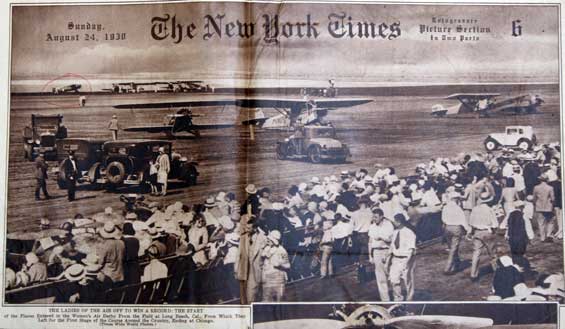 |
Tucson News Description of Doig's Accident, August 19, 1930
(Source: Sala)
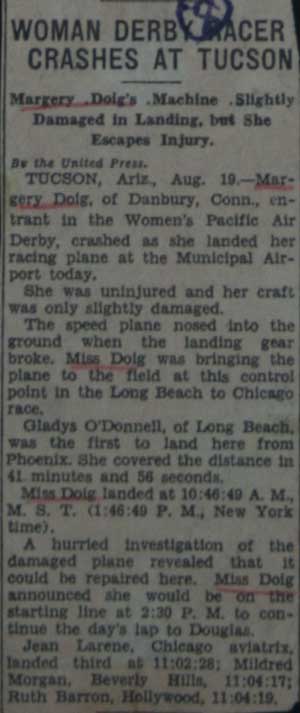 |
Another interesting feature about the photo above is headgear. Despite the fact that most people are wearing hats, there are two people of special interest. They are at lower left wearing what looks like striped caps. One person is the first on the left of the front row of seats, and the other is just to the right of the two people standing up in the rear row (he would be the 6th person from the left). This headgear is a sunshade, similar to the one you can see on Hub Fahy's Web page (look in Fahy's right hand).
Wearing race number "2", Doig records the beginning of the 1930 NAR on page 23 of her log, with the first leg of the women's race from Long Beach to San Diego on August 17th. She then flew the next day from San Diego (Lindbergh Field) to Phoenix, then, on the 19th from Phoenix to Tucson.
Although her log places her there, there is no record in the Register of her landing at Tucson on the 19th. Little wonder, as she was involved with the race. We know she was delayed in Tucson, however.
The reason for the delay was that, because of a blown tire, her airplane nosed over on its propeller, which required repairs. Both the accident and the repairs were captured in the news and in photos. At left, the local Tucson article from August 19th.
In a feat of great industry, having landed at 10:46AM, Doig set her goal of a 2:30PM departure. That she did this is supported by other news articles where she was still placed second at Douglas, AZ, the next stop in the race. Below, a candid snapshot of NC96W on its nose at Tucson.
Pitcairn NC96W on its Nose at Tucson, August 19, 1930
(Source: Sala)
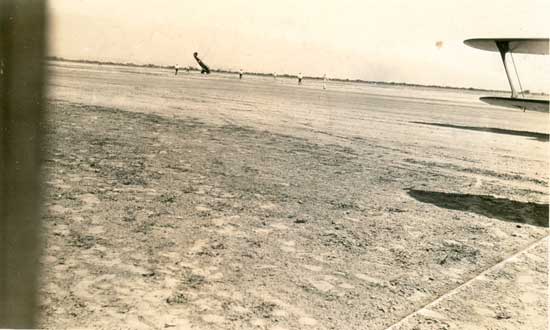 |
This photograph was taken by one Fred Patton of Tucson. He mailed it to Doig after the race with the annotation, below, on the back, offering good wishes and suggesting that she might like to have, "... a record of your stunts." Interestingly, above, the interwing I-strut and aileron linkage visible on the wingtip of the airplane just out of view at the right looks a lot like those on NC21M, the airplane flown by Gladys O'Donnell (see below). O'Donnell had just landed in first place minutes before Doig, who held second place from Long Beach. In the original image, seven people can be seen rushing to Doig's aid. Under magnification , the tall, slender person farthest on the right is wearing a white jump suit and white helmet. This person could very well be O'Donnell rushing to help her friend and fellow competitor.
Pitcairn NC96W on its Nose at Tucson, August 19, 1930, Caption
(Source: Sala)
 |
The news articles below, dateline Douglas, AZ, have Doig still in second place behind Gladys O'Donnell. She was in good company, as the articles have her accompanied by Register pilots Ruth Barron, Jean LaRene, Mildred Morgan and Ruth Stewart.
Unidentified News Article, August 19, 1930 (Source: Sala)
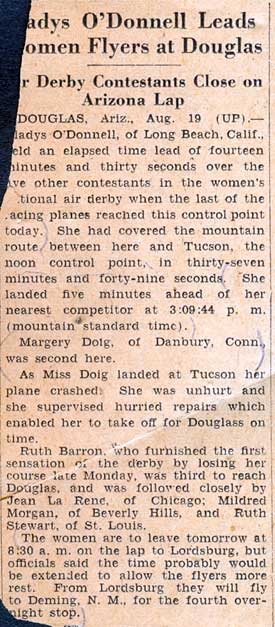 |
Unidentified News Article, August 19, 1930 (Source: Sala)
 |
Unsourced Kansas City News Article, Ca. August 23, 1930
(Source: Sala)
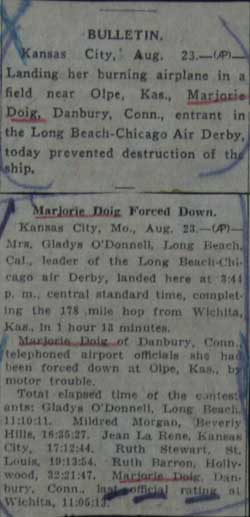 |
After a few more legs of the race, on August 23rd near Wichita, KS, her airplane suffered a piston failure and she was finally forced down (pilot log page 23). She remarked in her log, "Finis". Although out of the cross-country race, on August 27th after repairs she continued on her way and arrived at Chicago on the 28th.
Despite the nose-over at Tucson and the engine problem in Kansas (which took four days to repair), she proceeded to Cleveland and placed 4th out of the money in Event 32-A, the Women's Free For All. She also placed second in Event 34, the Women's 800 cu. in. Open race (winning $450). See articles below.
Below, a "scorecard" for the race for logging progress of the pilots at an unidentified municipal airport.
Women's Air Race, Scorecard, 1930
(Source: Sala)
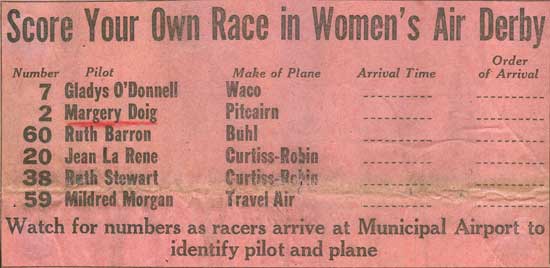 |
Below, a photograph of Margery Doig in the cockpit of her Pitcairn. This photo was probably taken during the 1930 NAR, because her race number is on the side of the fuselage. Exact date and location are unknown. The red fuselage and cream wings are shown to good advantage (see the page for NC96W for color information), as is her name painted below the cockpit coaming. Notice the front passenger cockpit covered over for streamlining. The engine is running.
Margery Doig and NC96W, Date & Location Unknown
(Source: Sala)
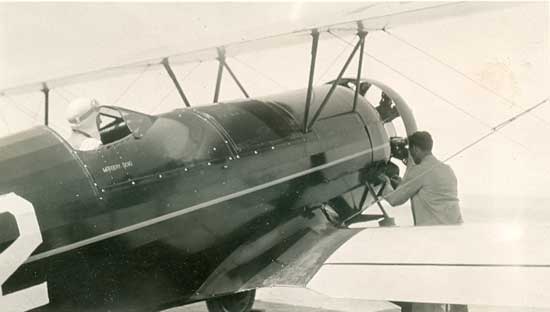 |
1930 National Air Races, Washington Post, August 18, 1930
(Source: NASM)
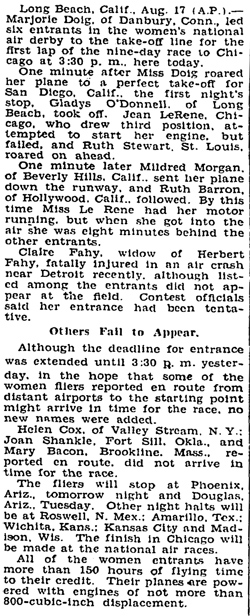 |
The news article, left, from the Washington Post of August 18, 1930, reads like a who's who of female pilots who signed the Davis-Monthan Register at one time or another. Besides pilot Doig, and the others highlighted above, represented are Claire Fahy and Joan Shankle.
Doig's family scrapbook contains many other news articles that follow her from town to town and day to day during the 1930 race across the country. They all report competitor positions and other significant happenings, including lap prizes and entertainment, for the individual race legs. Many are redundant, so they will not be exhibited here.
Ultimately, 1st place in the women's cross-country race went to Gladys O'Donnell in her Waco Taperwing, 2nd place to Mildred Morgan in her Travel Air (NC8192), and 3rd place to Jean LaRene in her American Eagle. This was the second annual women's race. The first, in 1929, earned the moniker "Powder Puff Derby" when Will Rogers named it so.
On August 29th Doig competed in the 800 cu.in. closed-course race and placed 2nd behind O'Donnell (unsourced news article, below).
On September 3rd she competed in the free-for-all race. She departed Chicago on the 3rd, arriving back at Bridgeport on the 7th. Curiously, she next took a winter break from flying. The next entry in her flight log was March 22, 1931 (page 25).
Below, the results of the 800 cu.in. 25 mile race of the 1930 NAR, dateline Chicago, IL. Mentioned in the article, besides Doig and O'Donnell, are Register pilots Mildred Morgan (linked above), Charles Lindbergh, James Doolittle and John Livingston. Betty Lund, wife of Freddie Lund, is also mentioned. The Golden Age pilot community was tightly-knit, and met at most of the significant aviation loci of the era, including at one time or another the desk at Tucson that held the Davis-Monthan Airfield Register.
Chicago Newspaper Article, August 29, 1930 (Source: Sala)
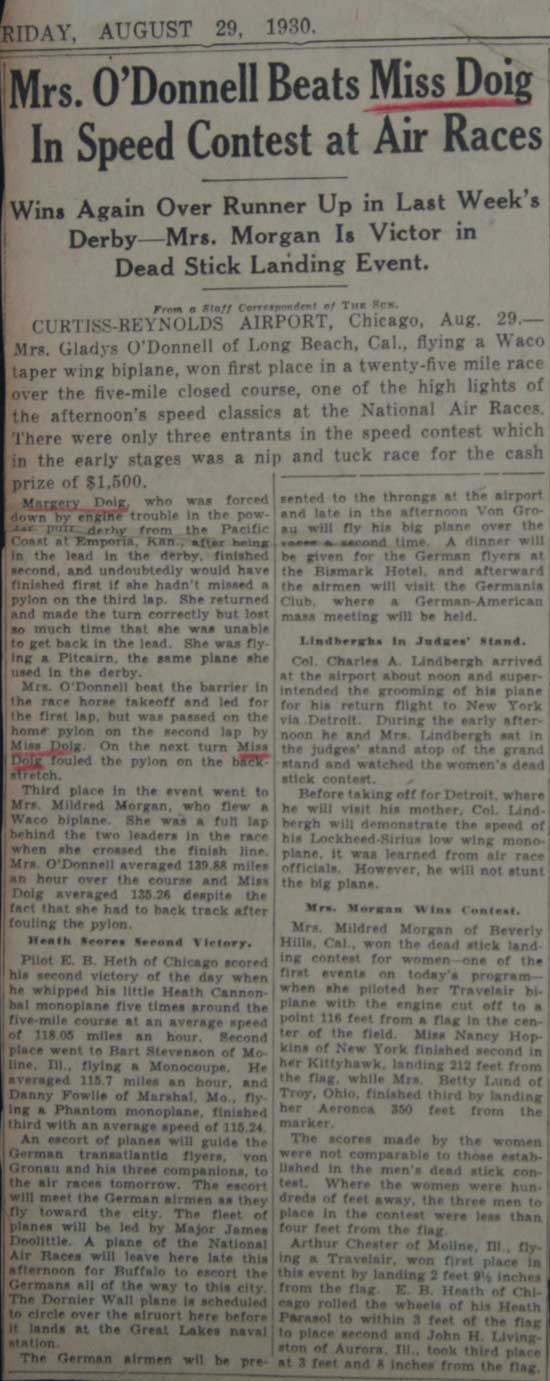 |
Image, below, from an unidentified magazine dated October, 1930, shows some of the competitors in the 1930 women's race. All these women are Register pilots and links to their individual biography Web pages appear above.
Women In the 1930 National Air Races
(Source: Sala)
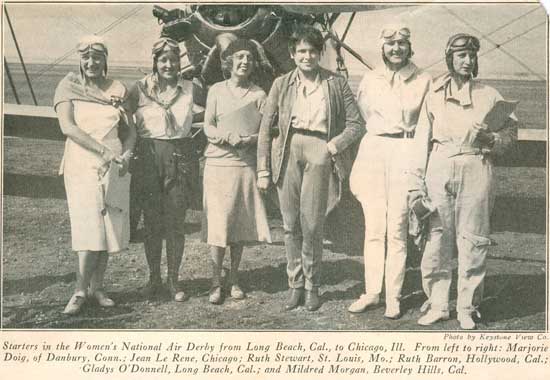 |
Proposed NJ Racing, October 14, 1930
(Source: Sala)
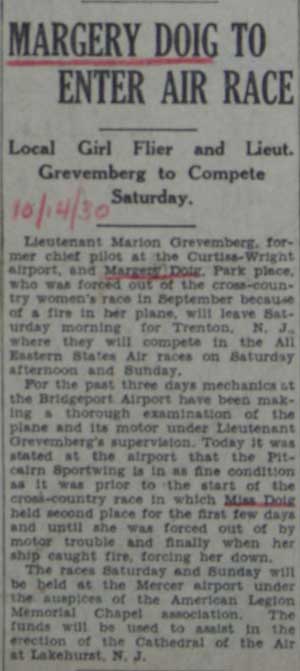 |
Further to 1930 racing, the news article, left, describes a trip for air racing at Trenton, NJ. dated October 14, 1930. There is no record in her pilot log book that she ever made the trip to New Jersey (p. 26). In fact, her log shows a hiatus in her flying between September 17, 1930 and March 22, 1931.
Doig also took NC96W to Cleveland for the 1931 NAR. Surprisingly, she did not document any details in her log (page 25). She notes simply "Racing" at "Cleveland" in NC96W for a total of 45 minutes on September 3rd and 6th.
1932 NAR Wm. B. Leeds Trophy Race
(Source: Sala)
 |
Right, from the New York American of August 28, 1932, preparations for the 1932 NAR with Clyde Pangborn (not a Register pilot). Pangborn placed 8th in this event (his prize was $50) from Roosevelt Field to Cleveland for private owner planes only.
It is not clear whether Doig accompanied him to Cleveland, but her flight log, page 29, shows she did not fly NC96W between June 4th and September 5, 1932. Likewise, in the Aircraft Yearbook for 1933, which reported results for the 1932 NAR, Pangborn is cited as flying a Pitcairn aircraft with a Wright J-6 engine. Chances are it was NC96W.
1932 NAR Wm. B. Leeds Trophy Race (Source: Sala)
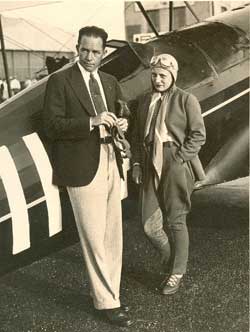 |
Above, left, a photograph taken almost contemporaneously with the one at right. Behind them is Doig's NC96W. Pangborn's race results, and Doig's flight log, together suggest she was not with him at Cleveland (corroborated by the fact that the front cockpit was covered over, too).
Flipped News Photograph
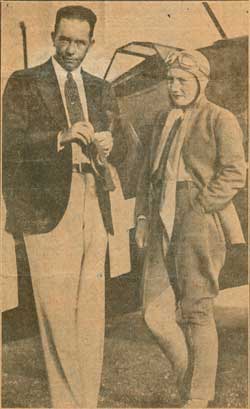 |
Interestingly, if you examine the details of the two images above, you can see they were snapped probably within seconds of each other. One of the photos was flipped horizontally for printing, probably the news shot. Friend of dmairfield.org (and owner of Register Pitcairn NC6708), David Pitcairn, states about the image, "You are right about which photo is flipped. It is the news shot because the other photo is clearly of the right hand side of the airplane because the left side has a zipper just above the cream stripe. The zipper runs from the inst. panel to the firewall and provides access to the electrical wires and can be seen in one of the last photos on the page which shows the left side."
Chances are, too, they were taken by two different photographers. At left, I flipped the news photo in PhotoShop. Now notice the parallax change when you compare the position of Pangborn's head against the windshield in the background of the photo above, left (the news photographer was standing to the other's right!). Further, there is a slight change in Pangborn's finger positions, and in his and Doig's gazes.
Regardless, the annotation on the article states "they" started to Cleveland, so it may be that she did accompany Pangborn in her airplane, but not as pilot in command of the ship, since there is no record in her pilot log of her flying the plane. The front cockpit cover could have been removed, carried to Cleveland and reattached.
Regardless, again, according to her flight log, NC96W was back in Connecticut by September 5th. Doig logged a round-robin flight to Montgomery, NY on that day. By the end of December, 1932, she had accumulated about 235 flight hours.
Next, I include the image below not because of any known related significance to her racing career, since we don't really know where or when it was taken. But, her jacket looks like the one she is wearing in the two images just above (note collar design and elasticized cuffs). Note the monogrammed purse.
Margery Doig and Unidentified Man, ca. 1932
(Source: Sala)
 |
Of interest is the annotation that appears on the back of this photo. The point that sexism was rampant in the news of the 30s was made here (see the bottom right sidebar at the link). This photo ID is a good example.
Margery Doig and Unidentified Man, ca. 1932, Annotation
(Source: Sala)
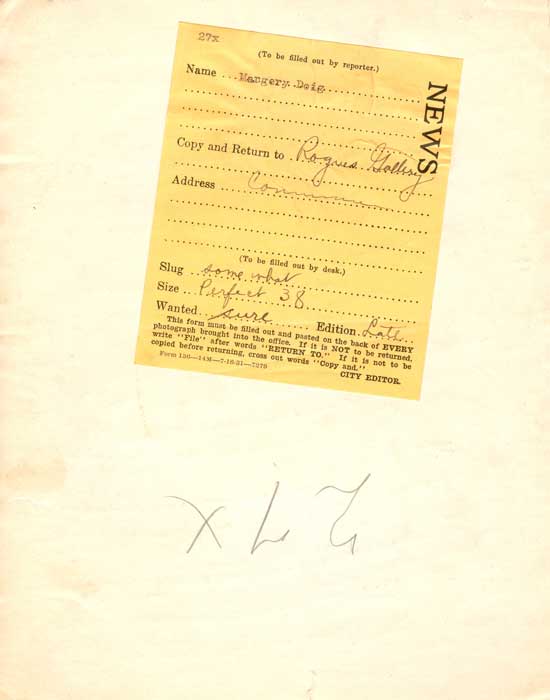 |
Doig and Pangborn had another project in mind. That of a trans-Atlantic flight is alluded to in the undated article from the New York World Telegram below (bottom of the 4th column). Note the harsh criticism Doig offers for her sister pilots.
Margery Doig, Undated News Article
(Source: Sala)
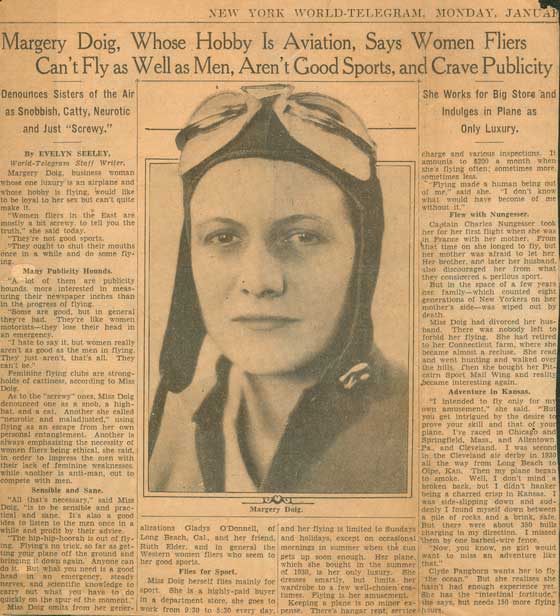 |
Margery Doig, Trans-Atlantic Plans, February 1,1932
(Source: Sala)
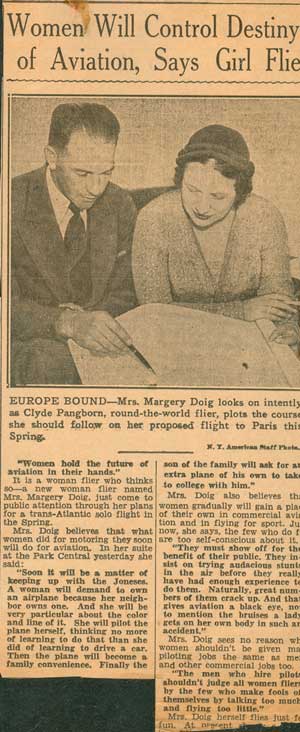 |
And their project is broadened amidst some editorializing in the article at right from the New York Times of February 1, 1932. Although this article is truncated at the end, it reflects the same kind of open animosity pilot Doig seemed to have toward her eastern sister pilots.
Going public with, "Women fliers in the East are mostly a bit screwy...." and calling at least one of them, "neurotic and maladjusted" may not be a way to keep friends. Indeed, it may have been difficult for her to interact with them if they read what she had to say. Her opinion was repeated, below, in Popular Aviation (PA) magazine, November, 1933.
Popular Aviation, November, 1933 (Source: PA)
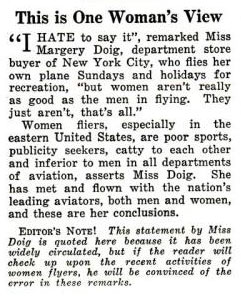 |
Interestingly, she did not feel that way about some of the western female pilots with whom she competed in the NARs.
Indeed, her outspokenness flies in the face of what her grandchildren had to say about their grandmother. They found her always pleasant, with M&M candies continuously available in the pocket of her apron.
Regardless, as far as I know, Doig and Pangborn never mounted, attempted or completed a trans-Atlantic flight.
BACK TO TOP
---o0o---
TOTAL FLIGHT EXPERIENCE
A summary of Margery Doig's flying experiences, as researched from her pilot flight log, is as follows:
First logged flight, June 10, 1929 in Curtiss Fledgling 265H (not a Register airplane). Her flight instructor was John Battle.
On July 19, she had her first instructional flight with Marion Grevemberg in Curtiss Fledgling 265H.
On September 16 (page 8), she had her check ride with Captain Generous and her first, 10-minute, solo flight in Curtiss Fledgling 8672 (not a Register airplane).
By the end of 1929, she had logged 45 hours and 25 minutes of flight time.
She took a month's hiatus (weather; holidays?) and began flying again in February, 1930. She began a series of cross-country flights in the northeast (Boston, Providence, Hartford, etc.).
"Threw Baseballs For Eastern League Opening", Bridgeport, CT, April, 1930 (Source: Sala)
 |
In one of the few annotations made in her flight log, she noted on April 16, 1930, "Threw baseballs for Eastern League opening" in Bridgeport, CT. News photograph, right, shows her technique. They were probably some of the longest pitches in history (pp. 15-16).
On May 3rd she flew to Pitcairn Field, PA via an "Air Parade over NY". In Pennsylvania she flew two Pitcairn PA-7 aircraft, NC96W and NC213W. It appears she stayed in Pennsylvania for about a month. She purchased NC96W and returned with it to Bridgeport by May 30th (page 18).
On June 21, 1930, she flew from Bridgeport to Allentown, PA to compete in the Allentown Air Meet. She took first prize in the Women's Race. This air meet is recorded in an undated and unsourced article in her scrapbook (above).
New York Times, December 18, 1930
(Source: NASM)
 |
On July 30th she departed cross-country for California and the 1930 NAR. She came to Tucson after 16 flight legs on August 1, 1930. Note from her itinerary west, that she flew the race waypoints in reverse. Compare her log pages 19-22.
She had accumulated152 hours and 35 minutes as of August 15, 1932. She was, thus, a very low-time pilot as she entered this race.
Between August 17th and September 7th (pp. 23-26), she logged her participation in the 1930 NAR and return to Bridgeport, CT.
An interesting finding is that the article at left, from the New York Times of December 18, 1930, describes Doig's pending participation in an aerial relief effort. She was to join a number of her female colleagues and fly over Manhattan in a show of support for the Salvation Army's drive for unemployment relief (The Great Depression was a little over a year old).
There is no annotation in her flight log book regarding this flight. In fact, there is a gap in her log between September 17, 1930 and March 22, 1931. We do not know why there was a six-month hiatus in her flying. That she did not participate in this event is supported by a second article from the Times dated December 19, 1930, below. There is no mention of her flying that day.
New York Times, December 19, 1930
(Source: NASM)
 |
When she continued her log in the spring of 1931, it appears she flew mostly locally in the New York City area. In September, she goes to Cleveland for the NAR (see above). There she takes Register pilot Ruth Elder for a 25-minute ride (page 26).
Through the fall and into the summer and winter of 1932 she expanded her fleet of flown airplanes, adding Travel Air 6000B NC696K, Fairchild 22s NC10774 & 12641, and American Eaglet NC550Y. None of these are Register airplanes. She flew mostly to destinations in New York, Connecticut and New Jersey.
Her last flight in her Pitcairn NC96W was on November 27, 1932. The official FAA record for the airplane contains a letter dated August 24, 1932, handwritten and signed by Doig, requesting from the Department of Commerce (DOC) a Form AB-16 (bill of sale) since she, "... just sold the airplane." A further letter to the DOC, dated February 17, 1933 confirms the purchase of NC96W by Pennsylvania Airlines, Inc., based at the Pittsburgh-Butler airport. By the end of December, 1932 she had accumulated 235 hours and 45 minutes of flight time.
She flew through the rest of 1932 and most of 1933 taking trips mostly of less than an hour. She flew only 696K and 12641. We can wonder if the sale of her airplane and the reduction of her flying hours was a result of the global economy of the time.
On February 28, 1934 she departed for Washington, DC (page 34). She flew NC696K. From Washington, she continued south to Richmond, VA, Fayettville, NC, Charleston, SC, Savanah, GA, Jacksonville and Daytona, FL, arriving in Miami on March 5th. She remained for nine days (vacation, Miami air race?) and began the reverse trip on April 14th arriving back north on the 16th. She noted that she was "pilot & co-pilot", but no mention of who accompanied her is in her log book.
On September 7, 1934 she flew to Cleveland, OH, returning to Flushing, NY on September 12th. This flight was probably not to attend the NAR that year, as it was held August 31st-September 3rd. On November 3, 1934 her last flight is logged in the Waco C NC13031. She had accumulated just over 300 total flight hours. There are no further log book entries, so it might be assumed that she stopped her flying activities for some reason. There are no other flight log books among her family's records.
BACK TO TOP
---o0o---
AIRPORT AERIAL VIEWS
Among Margery Doig's photographs were a few aerial pictures of airfields. I have not been able to identify any of them, or relate any of them to the flights in her pilot log. I put them here and solicit your INPUT on any you may identify.
The first one, below, appears to be located just outside a busy industrial area on a waterway. Under magnification of the photos, the lettering on the top of the near hangars appears to say "STOCK YARD", and in the other direction, "BEEF PORK". The far hangar appears to say "YORK" or "PORK" on top, and two other unreadable words.
Margery Doig, Unidentified Airport
(Source: Sala)
 |
The next one clearly says "SPEEDATHON" on the roof of the largest building just to the right of the water tower. "Speedathon" may not be related to the name of the airport. Rather, it may be a building where marathon dance contests were held before they became outlawed in 1937. Please direct your browser to this link to learn about the marathon dance fad known as "speedathons", and why there was a movie named "They Shoot Horses, Don't They?"
Margery Doig, Unidentified Airport, "SPEEDATHON"
(Source: Sala)
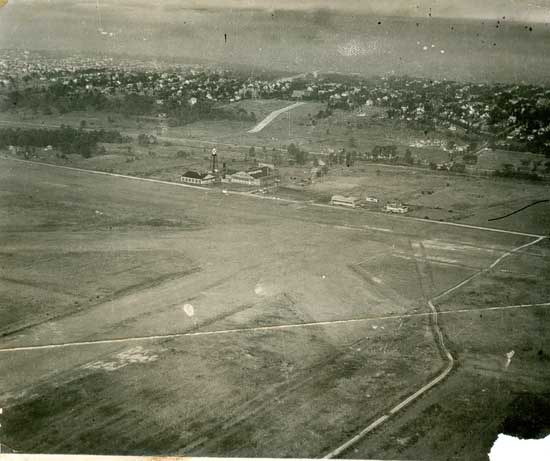 |
Interestingly, behind the water tower is what appears to be a plateau area with a road leading up the slope, and homes on the right side. This looks like a modern topped and covered sanitary landfill. However, what became known as the first sanitary landfill in the U.S., at Fresno, CA, was opened in 1937 and was in operation for over 50 years. The timing of this first landfill and that of the probable timing of this photo are not compatible, so it's probably not a landfill site. Follow the Fresno link to learn that the Fresno landfill recently became a U.S. National Historic Landmark.
The last airfield is a Curtiss-Wright operation, as evidenced by the lettering on the top of the near hangar. Comparing this image to other known images, it is not the Curtiss-Reynolds field in Chicago that hosted the 1930 NAR. Could it be Bridgeport, CT where she was based and learned to fly?
Margery Doig, Unidentified Airport, "Curtiss-Wright"
(Source: Sala)
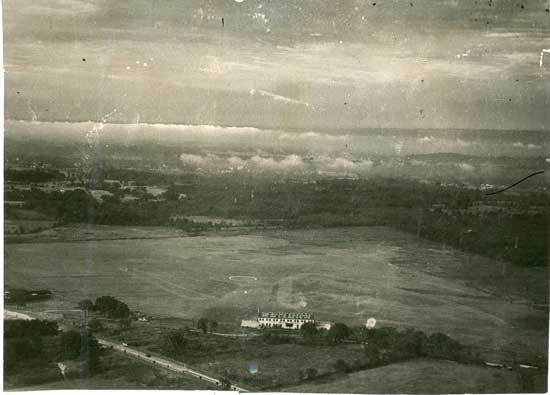 |
BACK TO TOP
---o0o---
MISCELLANEOUS
Below, two versions of an unidentified group of people standing next to Pitcairn NC96W. The airplane still wears the race number from the 1930 NAR (although it appears to be a bit weathered). It looks like Doig standing behind the child.
Unidentified, Undated Group With Pitcairn NC96W
(Source: Sala)
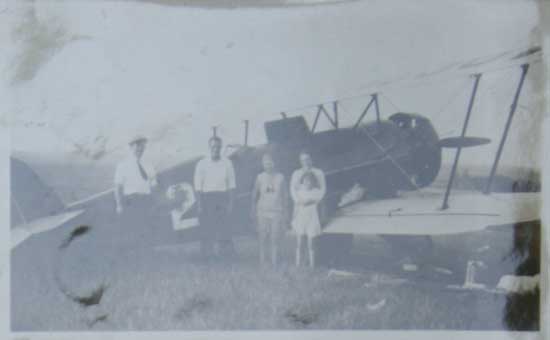 |
Below, this second copy of the same photograph is pushed with PhotoShop. Sadly, very few details emerge. This may have been an outing, as there appear to be picnic items under the wing. Date, location and other people unknown (although the second gentleman from the left could be Marion Grevemberg).
Unidentified, Undated Group With Pitcairn NC96W, Enhanced
(Source: Sala)
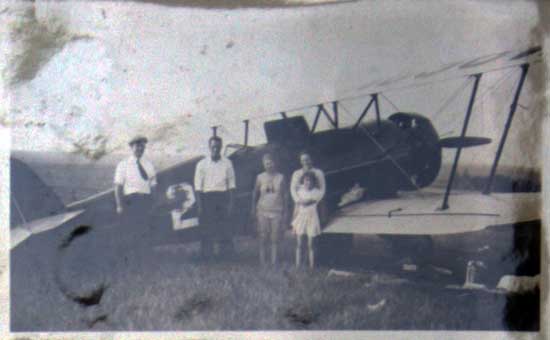 |
Below, Doig stands at center with five men at an unknown place and date. One of the men is identifiable. If you compare this image with the one of Doig with Clyde Pangborn, above, you'll note that the second gentleman from the left is Pangborn. At far left could be Marion Grevemberg. Compare with image just below this one, and another image of him at the Cosgrove Collection. Not sure of this one, though. Further, from the interwing strut geometry, the airplane does not appear to be her Pitcairn. Rather, the wing and struts look like those of a New Standard. Compare the wing plan of NC9194, the oldest flying New Standard D-25 shown to advantage at the link.
Margery Doig With A Group of Men
(Source: Sala)
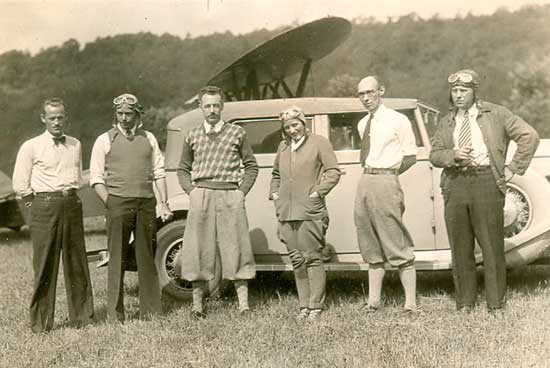 |
Amsterdam (NY) Daily Democrat & Recorder, August 25, 1929
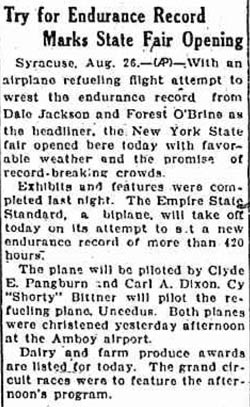 |
Indeed, according to Plehinger, NR9194 participated in the men's landplane endurance record, acting as the supply aircraft for another New Standard D-25, NR182H (named "Empire State Standard"; not a Register airplane). "Empire State Standard" was flown by Clyde Pangborn, with Carl A. Dixon as copilot. Register pilot Hugh Herndon and two others managed the refueling in NR9194, which was, for the event, named "Uneedus". Alas, the flight lasted only 179 hours, 41 minutes (August 26-September 2, 1929), being forced to discontinue by a broken oil line. The record attempt was unsuccessful. So the airplane in this photograph could be either NR9194 or NR182H.
The news article, left, cites the beginning of the endurance event and dates the photo above to sometime near the end of August, 1929. From the grim look on most of their faces, the photo may have been taken after the event. Can anyone IDENTIFY any of the others?
Below, Marion Grevemberg. The wing-to-fuselage fairing is shown to good advantage. Date and location unknown.
Marion Grevemberg (?) Standing Next to NC96W
(Source: Sala)
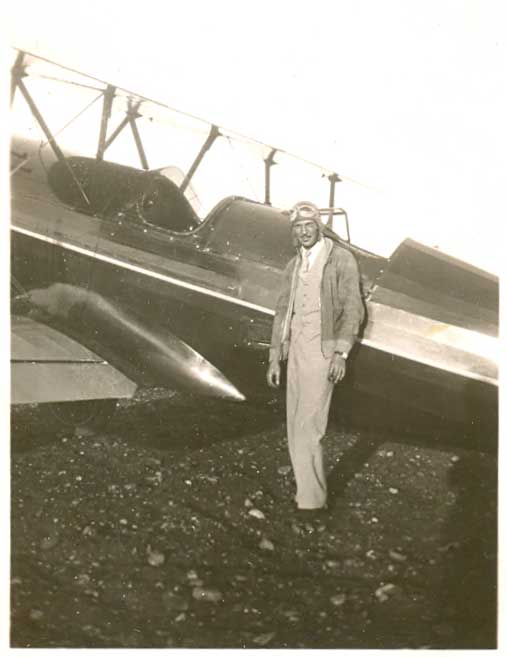 |
Below, Marjorie Doig, right, with four others. The gentleman at far left looks a lot like Clyde Pangborn. The other three are unidentified, as are the date and location. Does anyone have any INFORMATION about Knickerbocker AviaTIOn? What about the airplane? The window geometry and the curve of the belly of the fuselage look a lot like those of the Travel Air 6000B. The airplane could be NC696K.
Margery Doig (R) And Clyde Pangborn (L)
(Source: Sala)
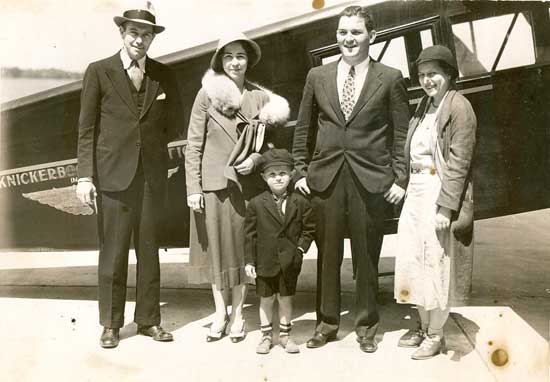 |
"Tailspin Tommy" was a well-known and popular comic character of the late 20s and 30s whose popularity was driven by the growth of Golden Age aviation. Doig, as well as some of the female pilots competing in the 1930 NAR, are mentioned in this copy, below.
Bear with me as I exhibit the strip vertically, since to place it across your screen would make the print too small to read. At least one other Register pilot was touched by "Tailspin Tommy". Hap Russell, when he flew for American Airways, carried Hal Forrest, creator of the character. The letter Forrest wrote to Russell is here. We know this particular strip is pre-1933, because author Chaffin's name is still associated with it. Forrest bought out Chaffin in 1933.
"Tailspin Tommy" Strip From Near the 1930 NAR
(Source: Sala)
 |
Below, from a slip pocket attached to the rear cover of her pilot log, Margery Doig's certificate of medical examination dated November 24, 1930. There is no notation in her log book (p. 28) of the receipt of this certification. Pilots today must pass a periodic medical exam in order to maintain their cockpit privileges.
Margery Doig's Medical Certificate, November 24, 1930
(Source: Sala)
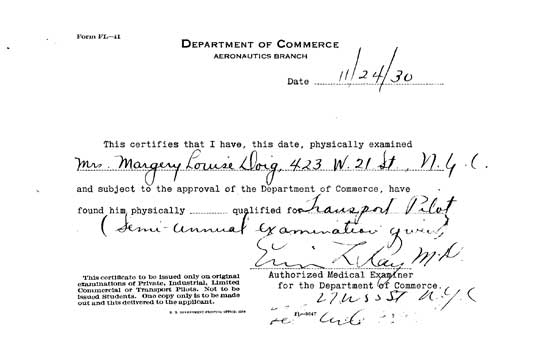 |
Below, one of the real pleasures and perks of my work with the Register and dmairfield.org, enjoying a refreshing beverage with a Register pilot's family after spending most of the day scanning, photography and talking. Our primary correspondent, Margery Doig's grand daughter Lyn, is second from left and grand daughter Jennifer Fairchild Smith is at right. Great grand daughter Emma Fairchild Smith is at left. Doig's daughter, Susan, was unable to join us this day, although she did provide information for this page via email.
Your Webmaster With Margery Doig's Family, August 8, 2009
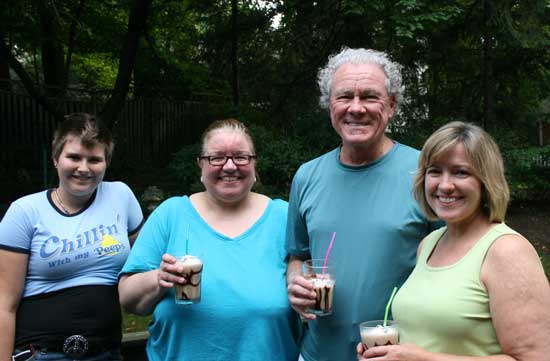 |
BACK TO TOP
---o0o---
Dossier 2.4.29
THIS PAGE UPLOADED: 11/02/09 REVISED: 07/26/10, 11/30/10, 06/26/14
|























































